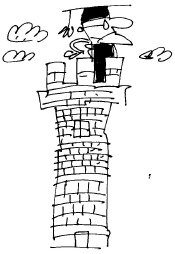A subject I keep coming back to is the ‘nature’ of the English writing system. I keep doing this because lack of understanding of how the sounds of the English language relate to the spelling system causes so many, (particularly) academics, to arrive at the most absurd and reactionary conclusions about how to teach it. And there can be no doubt that this has serious consequences for young learners.
The main culprits responsible for misdirecting teachers and, indeed, the public at large, are university academics. Almost every one of them is stuck in a conception of what phonics teaching is about that it is outdated and inefficient. As they sit in their ivory towers poring over more academic research that ‘validates’ their own thinking, they never set forth to test rigorously and over time the correctness of their theories in the classrooms of the English-speaking world. And yet they pontificate and pour scorn on anyone who has the temerity to challenge their view of the world.
That view of the world, clung to so tenaciously, is wrong, and it is wrong because it starts from a narrow and introspective view of what reading is about in the first place. As teachers of reading and spelling, let me state what our orientation should be. It should be from sound to print, an approach airily dismissed by Tom Nicholson, a New Zealand academic. Why it is sound to print is because a writing system represents the sounds of the language (Daniels and Bright, 1996) and this is no less true for the most complex of the alphabetic systems: English.
As professor Helen Abadzi (University of Texas) has remarked, the only constant in the spelling system is the sounds of the language. This is the ‘real’ basis for the alphabetic code and it is the sounds that ‘drive’ the code. The combinations of letters we call spellings are arbitrary symbols for those sounds.
Sounds, as I am constantly reminding trainees on our courses, are acquired naturally. They don’t need to be taught in school. On the other hand, a writing system is an invention and must be taught. As Peter Daniels has written, ‘no infant illiterate absorbs its script along with its language: writing must be studied’.
The question is: how? For a code to be reversible, it must be taught using the correct logic and in the right direction, i.e. from sound to print. A sound to print orientation enables the teacher to ground the teaching of phonics in the forty-four (or so) sounds of the language. If children are made aware that phonemes are the specific sound units on which the writing system is based, then they have a logic on which a schema can be built.
Starting with mutually implied sound to spelling correspondences, which are easy to learn, and which approach most clearly resembles a transparent orthography, such as Spanish, the complexities can then follow. The process begins slowly at first and then with increasing speed and accuracy over time to teach all the 175 or so common spellings of the forty-four sounds in the language.
Of course, learning the 175 spellings of the sounds takes time and patience: at least the first three years of schooling, after which knowledge, skills and understanding should be further developed through the greater complexities of more abstract, more technical, less frequently encountered spellings in genre-specific, polysyllabic words.
On the contrary, if, as the vast majority of academics believe, the code is taught from print to sound, from 175 spellings to several hundred ‘sounds’, the process collapses into chaos and into the absurd explanations, such as ‘silent letters’, ‘magic’ letters, ‘hard’ and ‘soft’ sounds, that graphemic phonics has to fabricate to try and make sense of it.
As anyone who reads this blog regularly will recognise: the posts are often polemical. And I make no apology for saying that the problem we have with the teaching of reading and spelling in UK, Australia, the USA, Canada, New Zealand, and so on, is that many academics seem to be mentally confined ‘within the “small circumscribed world” of their field of specialization’ (M. T. Clanchy, 2013). There is a disconnect between the theory and practice being developed by the practitioners of the new phonics and the untested theory of the academics and researchers.
Academics! You need to get out more often!
M. T. Clanchy, (2013), From Memory to Written Record, Wiley-Blackwell.
Daniels, P. T. and Bright, W., (1996), The World’s Writing Systems, Oxford

Can you provide a link to where Tom Nicholson goes wrong, John?
As with children and teachers, we have to live with the academics we have, not those that we would like to have. Since academics are tenured, modifying them is at best a generational matter. Focusing on instructional programmes is a much better prospect.
Hi Dick,
I'm sorry, I can't provide you with the link. Someone passed the comment on to me. Apparently, sound to print 'seems so wrong', as far as he's concerned. He's a prof at Massey University in New Zealand.
But, yes, you're right! Focusing on instructional progs is exactly what I'm doing – with the odd potshot at academics of course 😉